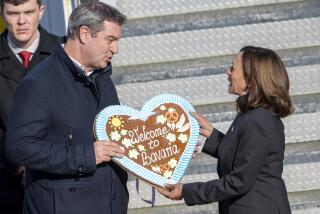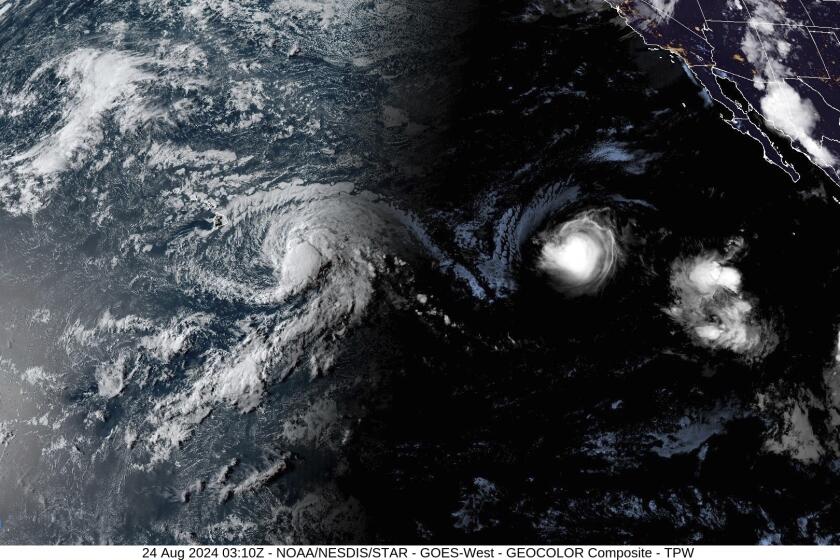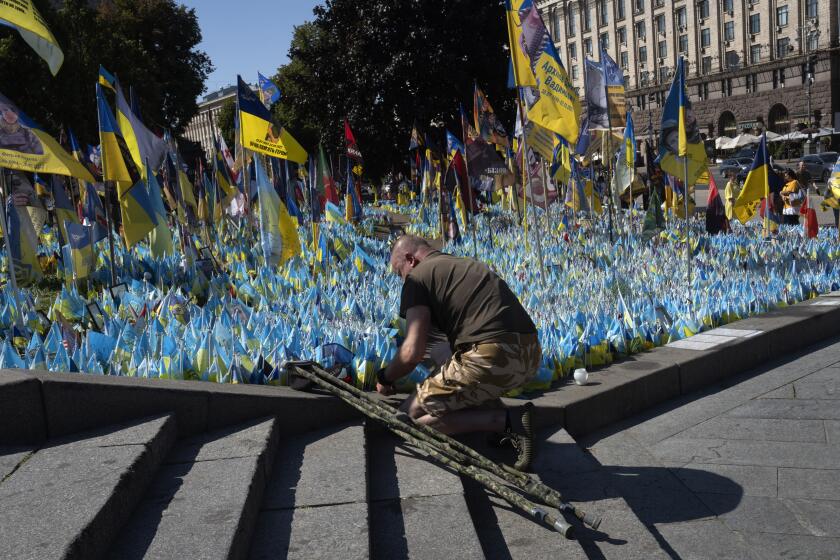Bush Visit to Come During Critical Hour for Latins’ Democracy and Economics : Diplomacy: The ouster of dictators and emphasis on free-market principles have laid the groundwork for the President’s trip.
The most flamboyant of the new South American presidents is Argentina’s Carlos Saul Menem, a lady’s man with fluffy two-tone sideburns and a flair for the dramatic gesture. He has locked his estranged wife out of the official residence, sold off the government telephone network and sent two warships to help out the United States in the Persian Gulf.
Patricio Aylwin of Chile is more conventional, a grandfatherly type in a gray suit, good at smoothing over rough moments. So far, Aylwin has handled with singular aplomb the delicate task of weaning Gen. Augusto Pinochet from power.
In Brazil, Fernando Collor de Mello has established himself as a domineering personality with the ego of a movie star and the zeal of an evangelist. “We are working with a sense of mission,” Collor declares.
For all their eccentricities and special problems, the elected leaders who have taken charge in South America since early 1989 have a lot in common. With popular mandates for change, they are giving the status quo a vigorous shaking--with an emphasis on freeing up the marketplace and solidifying democracy.
While the 1980s saw a transition from dictatorship to democratic government for South America’s 295 million people, for most countries it was also a “lost decade” of economic stagnation, rampant inflation and deepening poverty. The 1990s appears to be a make-or-break decade.
It won’t be easy for the new leaders to meet their people’s expectations, but for the first time in decades South America’s governments appear to be pulling together in the same direction.
They have discarded old formulas of state economic control and unbridled deficit spending. Even the most left-leaning of the new presidents advocate free-market policies and government solvency. And while they were elected in a climate of social unrest, even the most conservative of them see a growing need for government investment in education, health care and housing.
With dictators out and free-market principles in, the continent’s policies mesh well with those of Washington. To build on that base, President Bush is scheduled to leave Monday on a trip to five of South America’s democratic nations--Argentina, Brazil, Chile, Uruguay and Venezuela.
Though far from uniform, the policies of the new presidents are enough alike to once again raise hopes for continental unity, the grand goal that has frustrated South Americans since independence from Spain.
Now, as powerful economic blocs take shape in Europe, North America and Asia, South American presidents are renewing efforts for economic integration. Common-market projects in the continent’s southern cone and along its Andean spine are taking on new urgency.
But the first step, the leaders acknowledge, is to restructure their own national economies. That typically means reducing public payrolls, slashing subsidies, squeezing the supply of money, even ushering in recession.
There is no guarantee that the new presidents won’t reverse course. Previous South American presidents have announced similar economic reforms, then relented when the political costs of austerity became too great. But without economic restructuring, the new leaders also run serious political risks. Waves of hyper-inflation and economic uncertainty were ruinous for some predecessors.
Here are the chiefs of state whom President Bush will meet on his forthcoming trip:
BRAZIL’S COLLOR
Clamor for change in South America was nowhere louder than in Brazil, a nation of 150 million people, when it elected maverick Fernando Collor de Mello. Since taking office March 15, Collor has put the pudgy public sector on a strict diet and given the coddled private sector a kick. His program includes measures that almost all of the new South American presidents favor: balancing the government budget, cutting official subsidies, lowering import barriers.
Handsome, athletic and a sharp dresser, the 41-year-old leader conveys self-confidence and macho determination, even when things are going badly--as they have begun to lately.
The government has failed so far to meet its first priority, controlling inflation. Though it has come down from a disastrous monthly rate of more than 80% in March, it still hovered at 14% in October despite recessionary austerity measures. Criticism is spreading, but Collor is pressing on.
“Brazil knows that we will never back off from a fight,” he told his Cabinet at the end of October. “We promised to change the country, and that is what we are doing and that is what we will keep doing.”
But in a private meeting with his economic team, according to Istoe Senhor magazine, the president worried about the fallout from his program: “You must do something. This is eroding our bases of support, and the pressures are becoming unbearable.”
URUGUAY’S LACALLE
Like his country, South America’s second smallest, President Luis Alberto Lacalle of Uruguay is pleasantly unspectacular, making little news that reverberates beyond its borders with Brazil and Argentina. Since taking office March 1, however, Lacalle has caused a minor domestic flap by pledging some of Uruguay’s gold reserves for cash to reduce the government deficit.
The terms allow the government to reclaim its ingots later, but the opposition accuses Lacalle of squandering national patrimony. The gold was socked away during the first half of this century, when Uruguay prospered from meat, wool and grain exports.
It was during those years that the country also built up the most elaborate welfare state in South America. In recent decades, the costs of the system have run national finances deep into the red. Lacalle, 49, has followed the continental trend, applying free-market policies as a remedy, promising to reduce the government’s role in the economy.
But unlike some other South American presidents, he refuses to fire government workers, preferring to reduce public payrolls gradually by attrition.
He is the first Uruguayan president elected in free voting since 1971. The armed forces, which took over the government when it faced an insurrection by the notorious Tupamaro guerrillas, permitted elections in 1984 but barred some politicians--including Lacalle--from running.
When Lacalle took office, he vowed that Uruguay will remain on the straight, unspectacular road of democracy. “The turbulent times of violence are over,” he said.
ARGENTINA’S MENEM
Carlos Saul Menem has been struggling with stubborn inflation since he took office in July, 1989. The other day he rejoiced in announcing that the October rate was “only” 7.9%. If compounded for a year, that would total 148%.
Menem, 60, a former provincial governor, often takes action without regard to the pro-labor positions of his Peronist party or even his own public pronouncements. Argentine sociologist Ricardo Sidicaro said the president’s ideas come more from personal contacts than any overall strategy or policy. “He doesn’t believe in ideology,” Sidicaro said.
In his battle against endemic inflation and economic stagnation, Menem has removed price controls, cut down the government deficit, reduced export taxes and import tariffs, and begun to privatize such state enterprises as the telephone company, ENTel, and the national airline, Aerolineas Argentinas. On a recent visit to Moscow, he said he found “profound similarity” between what he called “Menemtroika” and the Soviet Union’s perestroika .
The price of Menemtroika is recession. Argentine industrial output is expected to shrink by more than 6% this year after dropping 7.5% last year.
In sending two ships to the Persian Gulf, Menem also bucked strong nationalist sentiment against catering to U.S. interests.
CHILE’S AYLWIN
Patricio Aylwin has put his imprint on Chile calmly and gradually, asserting authority while former President Pinochet has remained chief of the Chilean army.
Pinochet turned over the presidency in March. But he has not given up the aura of command that goes with his army post and forceful personality. The general has continued to meddle in political affairs and has made veiled threats to exert military pressure on the government.
But Aylwin, 71, has skillfully consolidated support for democracy from the right and left, and has tactfully but firmly reminded Pinochet that the army now must answer to a civilian commander-in-chief.
A scandal involving army officers in the operation of an illegal loan syndicate has strengthened Aylwin’s hand by tarnishing the army’s public image. Early last month, he vetoed the promotion of two generals who are Pinochet proteges.
Pinochet helped build a growing market economy that in some ways has set an example for new South American presidents to follow. And Aylwin, a centrist Christian Democrat with support from moderate Socialists, is sticking to free-market principles.
With the increased cost of petroleum imports amid the Persian Gulf crisis, Aylwin faced a worrisome rise in inflation, which reached a monthly rate of 4.9% in September. When the rate dropped to 3.8% in October, the problem seemed less urgent.
VENEZUELA’S PEREZ
In oil-rich Venezuela, things have been going better for President Carlos Andres Perez since the Persian Gulf crisis boosted petroleum revenues. But Perez must avoid the “easy money” syndrome that got the country deep into debt and economic trouble during the 1970s. In a previous presidential term in the 1970s, in fact, Perez was responsible for much of the nation’s excessive spending.
But the recycled Perez, 68, has cut the budget, removed most price controls, reduced tariffs and prepared for the privatization of many state enterprises since he took office in February, 1989. The shock shrank the economy by 8% last year, but the new oil bonanza should give it a jump start.
Perez needed a boost, having paid a heavy political price for his economic reforms. After he cut subsidies and raised prices for gasoline and public transportation in February, 1989, rioting and looting left about 300 people dead.
More to Read
Sign up for Essential California
The most important California stories and recommendations in your inbox every morning.
You may occasionally receive promotional content from the Los Angeles Times.






